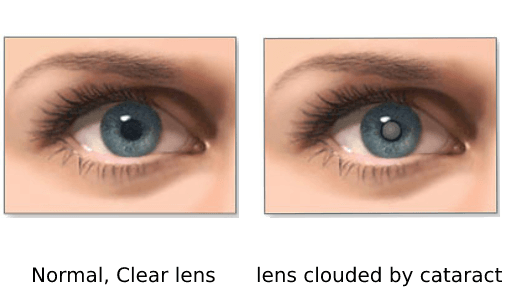Cataract Surgery
Cataract formation is not associated with "signals" such as Pain, Redness or Tearing.
The common symptoms are
1. Blurring or dimness of vision

2. Feeling of a film over the eyes

3. Sensitivity to light and glare

How is Phacoemulsification surgery done?
Cataract surgery is performed on an outpatient basis, and usually requires just a few hours of your time from start to finish. Your eye will be treated with anesthetic prior to the procedure so you'll feel little, if any, discomfort. First, a tiny incision will be made in the eye allowing your surgeon to use a small instrument (about the size of a pen tip) to break up or wash away the cloudy cataract. Once the cataract is removed, and the IOL will be inserted through the same tiny incision and set into its permanent position.
Phacoemulsification with intraocular lens implantation is the latest technique available for cataract surgery. almost all the cases are done by this method at our center. The ophthalmic surgeon decides whether the patient can undergo phaco or not.
Advantages of Phaco
- Early surgery can be done, so that patient need not wait for the cataract to mature
- Small Incision
- No sutures and no need of suture removal.
- No irritation, no watering
- Early return to work
- No need to continue drops for a long time
- No need for hospital stay, Even if the patient stays, it is only for a short time
Is phacoemulsification safe?
In the hands of a good surgeon phacoemulsifiaction is extremely safe due to these advantages
Small self sealing incision (3mm): Sutures are not needed due to the very small incision. This reduces the risk of astigmatism and foreign body sensation after surgery.
Topical Anesthesia: Anesthetic eyedrops is all what is required. No need for injections or general anesthesia.
Immediate recovery: No admissions to the clinic or bandages are needed. The patient may restart daily activities immediate. Just as any other surgical procedure, phacoemulsification has risks. One out of a hundred persons operated on with this technique has some sort of complication. In almost every case there is a solution to the problem. Severe complications are extremely rare.
Why at our center?
We have one of the latest phaco machines SOVEREIGN COMPACT—COLD PHACO. Normally heat is generated during phaco surgery due to ultrasonic waves which causes microscopic damage to the surrounding structures of the eyeball.This is prevented by cold phaco method.
- No injection
- No stitch
- No pain
- No admission
- State of art equipments
- Sovereign Compact cold phaco
- Carl zeiss microscope
- Quentel medical (axis ll)A scan
- Keratometer
- Nd Yag laser
To give you a crystal clear vision we use following IOL'S
- PMMA
- FOLDABLE
- Acrylic (Hydrophilic, Hydrophobic)
- Aspheric : Can Correct only Far Vision, but you will have to wear glasses for near work
- Blue Filter
- Toric
FAQ'S
Who will benefit from phacoemulsification?
Most people suffering from cataracts will benefit from this procedure. Best results are obtained in persons with early cataracts. It is preferable not to wait until the cataract is ripe and vision is excessively low since the cataract will be too hard for the phacoemulsifier. Surgery is indicated as soon as vision is not adequate for daily activities.
Do I have to undergo any investigations before surgery?
Your ophthalmologist will make sure there are no associated pathologies, which can interfere with the prognosis, by making an extensive examination of your eyes including pupil dilatation. A measurement of your eye's length and corneal curvature is crucial for calculating the power of the intraocular lens to be implanted. Systemic examination includes tests like blood sugar, blood pressure examination, ECG etc.
What should I do during surgery?
During the procedure your face will be covered with sterile drapes and you should keep your eye as still as possible. A small device will hold your lids open. Usually looking at the operating microscope's light is a good reference point. You will occasionally feel cold water over your eye that may even go down your cheek. This is the solution needed to keep your eye properly hydrated.
Is phacoemulsification painful? How long does it take?
Phacoemulsification is performed under topical anesthesia (anesthetic eyedrops). No injections or general anesthesia are required. The patient is awake during the procedure feeling no pain at all. Phacoemulsification takes about 15 minutes per eye. Once finished, you will go home without need for hospitalization.
What care should i take after surgery?
- Do not rub the operated eye
- Do not sleep on the operated side for3 to 4 days
- Use dark glasses for first 15 days
- Wash your hands thoroughly before application of drops
- Avoid washing eyes with water for 10 days
- Avoid head bath for 10 days
- Avoid playing with small children
- Avoid exposure to smoke, heat & dust
What results can I expect?
Over 90% of people achieve a vision better than 20/30 after phaco. If there is some kind of a retinal pathology this could not be the case. Reading glasses are the rule after cataract surgery.
Can a second procedure be necessary?
In some cases the capsule may opacify some time after surgery, compromising vision. In these cases a central perforation in the capsule is required to restore vision. This is called a capsulotomy and is achieved with a YAG laser. The capsulotomy is performed as an outpatient procedure and produces no pain. No anesthetic is necessary and rehabilitation is immediate.